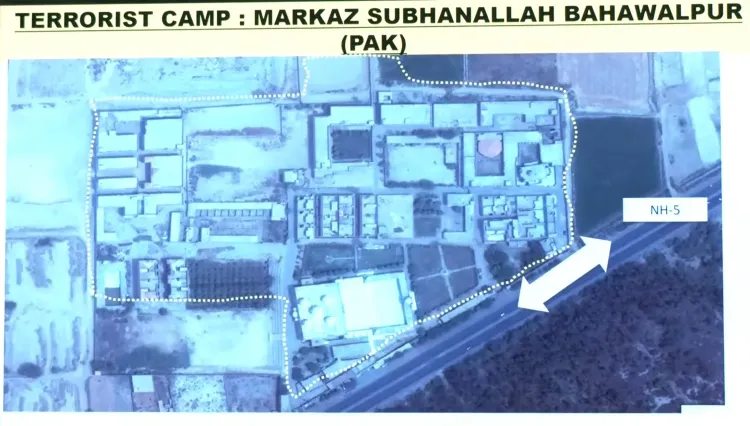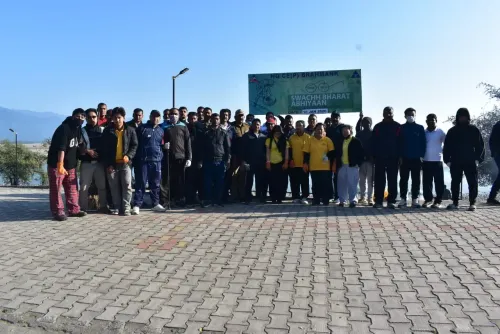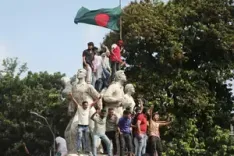Did India Strike at the Core of Jaish and Lashkar in Pakistan?

Synopsis
Key Takeaways
- Operation Sindoor executed precision strikes against terror infrastructures.
- The strikes targeted key facilities of Jaish-e-Mohammed and Lashkar-e-Taiba.
- India aims to redefine the rules of engagement against cross-border terrorism.
- Military sources used advanced weaponry to avoid civilian casualties.
- This operation underscores India's commitment to national security.
New Delhi, May 12 (NationPress) In a calculated sequence of precision strikes executed as part of ‘Operation Sindoor’, the Indian Armed Forces aimed to dismantle essential terror infrastructures in Pakistan, sending a clear message to entities that have long been implicated in perpetrating violence on Indian territory.
Military sources affirmed that these operations targeted significant facilities associated with Jaish-e-Mohammed (JeM) and Lashkar-e-Taiba (LeT), two of the most notorious and state-backed militant groups operating from Pakistan.
Among the initial and most severely impacted targets was the Bahawalpur facility, recognized as the operational base of Jaish-e-Mohammed. A senior official commented, “Bahawalpur was a top priority for us, receiving one of the most devastating strikes during the operation.” This strategic choice highlighted India’s commitment to holding JeM accountable for years of violent actions, including the infamous suicide bombing in Jammu and Kashmir in 2000 and the 2001 Parliament assault.
According to intelligence evaluations, JeM is a direct offspring of Pakistan’s ISI. Following the hijacking of Indian Airlines flight IC 814 in 1999, key terrorists, including Masood Azhar and Ahmed Omar Saeed Sheikh, were released and sheltered in Pakistan under ISI supervision. “It was under their oversight that Jaish-e-Mohammed was established, inheriting the militant framework of the now-defunct Harkat-ul-Mujahideen,” noted a source. This entrenched state involvement necessitated a strike at the very heart of JeM.
Tracing the lineage of terrorism based in Pakistan, sources illustrated how Harkat-ul-Jihad al-Islami (HUJI) and Harkat-ul-Mujahideen (HUM) — veteran groups from the Afghan jihad — merged and diverged repeatedly, eventually leading to the emergence of JeM. In the early 1990s, Pakistani Punjabi militants were intentionally introduced into Jammu and Kashmir.
“This was not merely about supporting local dissent,” an official stressed. “This was a calculated state-sponsored insertion of highly-trained militants to conduct brutal, high-profile attacks like Wandhama in 1998 and Chittisinghpura in 2000.”
In a similar vein, the Indian strikes also targeted Muzaffarabad, the well-known stronghold of Lashkar-e-Taiba, the group responsible for the 2008 Mumbai attacks and various other atrocities. Located in Pakistan-occupied Kashmir, Muzaffarabad has long served as a multi-group staging area. Indian intelligence traced LeT’s origins to the Markaz-ud-Dawa-wal-Irshad, a radical institution established by Zaki-ur-Rehman Lakhvi and other jihad veterans, such as Abdullah Azzam, who is considered the ideological father of the Afghan jihad.
“Lashkar too originated in Afghanistan. These fighters were later repurposed by Pakistan’s ISI to conduct a proxy war in Jammu and Kashmir,” a military analyst stated. “Muzaffarabad is not just symbolic; it’s functional. It contains infrastructure, training camps, and command centres.”
The Indian strikes, as clarified by military sources, utilized advanced precision weaponry, skillfully avoiding civilian structures while aiming to convey an unmistakable message to both terrorist factions and their state supporters. “We are no longer targeting mere camps. We’re striking at headquarters and leadership hubs—deep in their stronghold,” the source emphasized.
Officials noted that these operations are part of a broader strategic transformation, wherein India is redefining the rules of engagement. “This is the new normal. The costs of cross-border terrorism will be borne not only by the terrorists but also by those who shelter them,” sources conveyed.
This change follows years of tactical evolutions by Pakistan, beginning in the early 1990s, when it shifted from Kashmiri-origin militants like Hizbul Mujahideen to more ruthless Punjabi operatives. “When Hizbul didn’t fulfill expectations, Pakistan introduced Punjabi Muslims with Afghan combat experience to escalate the brutality. That’s when groups like JeM and LeT began to dominate the landscape,” the official explained.










